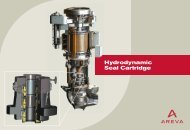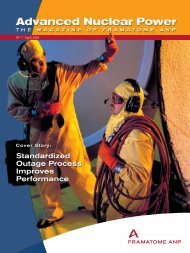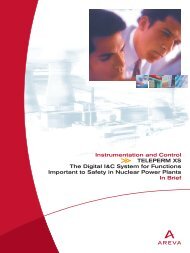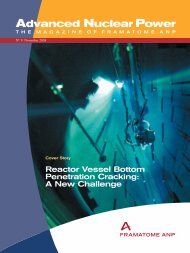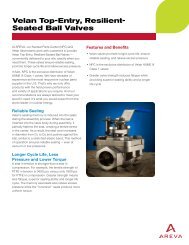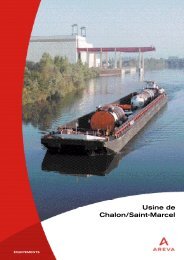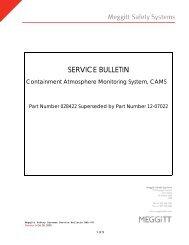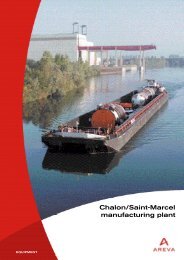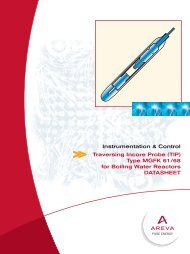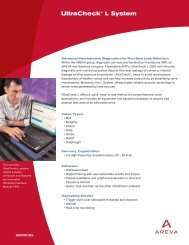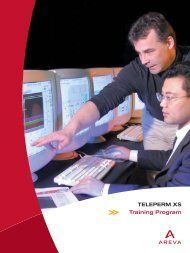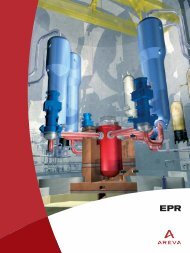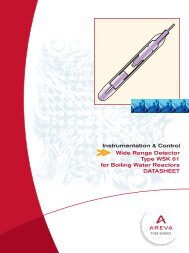Areva EPR
Areva EPR
Areva EPR
You also want an ePaper? Increase the reach of your titles
YUMPU automatically turns print PDFs into web optimized ePapers that Google loves.
<strong>EPR</strong> CONSTRUCTION TIME SCHEDULE<br />
The evolutionary approach adopted for the <strong>EPR</strong> allows its construction schedule to benefit from vast<br />
construction experience feedback and from the continuous improvement process of the methodologies<br />
and tasks sequencing implemented by Framatome ANP worldwide.<br />
Provisions have been made in the design, construction, erection and commissioning methods to further<br />
shorten the <strong>EPR</strong> construction schedule as far as possible. Significant examples can be given as follows.<br />
DESIGN FEATURES<br />
The general layout of the main safety systems in four trains housed<br />
in four separate buildings simplifies, facilitates and shortens<br />
performance of the erection tasks for all work disciplines.<br />
Location of electromechanical equipment at low levels means that it<br />
can be erected very early on in the program, thus shortening the<br />
critical path of the construction schedule.<br />
CONSTRUCTION AND ERECTION METHODS<br />
Three main principles are applied to the <strong>EPR</strong> construction and<br />
erection: minimization of the interfaces between civil works and<br />
erection of mechanical components, modularization and piping<br />
prefabrication.<br />
Minimization of the interfaces between civil works and erection.<br />
The on-going search for the optimization of interfaces between civil<br />
and erection works results in the implementation of a construction<br />
methodology “per level” or “grouped levels” enabling equipment and<br />
system erection work at level “N”, finishing construction works at<br />
level “N+1” and main construction work at levels “N + 2” and “N + 3”<br />
to be carried out simultaneously; this methodology is used for all the<br />
different buildings except for the reactor building, where it cannot<br />
apply.<br />
Use of modularization for overall schedule optimization.<br />
Modularization techniques are systematically considered, but retained<br />
only in cases where they offer a real benefit to the optimization of<br />
the overall construction schedule without inducing a technical and<br />
financial burden due to advanced detailed design, procurement or<br />
prefabrication. This approach enables the site preparation schedule<br />
to be optimized, delays investment costs with regard to start of<br />
operation, and so offers financial savings.<br />
For instance, modules are mainly implemented for the civil works of<br />
the reactor building, such as the reactor pit, the internal structures<br />
and the containment dome, as well as for the structures of the<br />
reactor building (and fuel building) pools, as they are all on the critical<br />
path for the construction of the reactor building.<br />
Maximization of piping and support prefabrication. Piping and<br />
support prefabrication is maximized in order to minimize erection<br />
man-hours and especially welding and controls at erection places;<br />
this measure also results in an even better quality of the piping spools<br />
with lower cost.<br />
COMMISSIONING TESTS<br />
As with the interfaces between civil and erection works, the<br />
interfaces between erection and tests have been carefully reviewed<br />
and optimized. For instance, teams in charge of commissioning tests<br />
are involved in the finishing works, flushing and conformity checks of<br />
the systems, so that these activities are only carried out once.<br />
Instrumentation & Control factory acceptance tests are carried out<br />
on a single test platform with all cabinets interconnected, which<br />
ensures a shorter on-site test period together with improved overall<br />
quality.<br />
The benefits drawn from the unique experience feedback gained<br />
from Framatome ANP’s past achievements, associated with the<br />
systematic analysis of possible improvements and optimization of<br />
construction, erection and test activities together with their interfaces,<br />
results in an optimal technical and economical construction schedule<br />
for the implementation of the <strong>EPR</strong> projects. This experience, and<br />
current <strong>EPR</strong> projects provide confidence that the <strong>EPR</strong> schedule is<br />
actually feasible and a reality.<br />
The short Olkiluoto 3 construction time-schedule, adapted<br />
to this particular project, is provided below as an illustration.<br />
2004 2005 2006 2007 2008 2009<br />
Main contract<br />
◆<br />
1st concrete pouring<br />
◆<br />
Start fuel loading<br />
◆<br />
Commercial operation ◆<br />
Construction license<br />
Site works<br />
Civil works<br />
Installation<br />
Operating license<br />
Start-up<br />
† The overall construction schedule<br />
of a new unit depends largely on site<br />
conditions, industrial organization and<br />
policies, and local working conditions.<br />
So accurate figures are valid only for the<br />
specific project to which they are related.<br />
I 53



